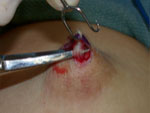Correction of Inverted Nipples
Most people who have inverted nipples are happy to hear about surgical corrections and how simple they can be. Inverted nipple repair is performed on nipples that have been inverted since birth or have become inverted due to breast feeding or other trauma. Recurrence of nipple inversion after surgical repair elsewhere is also a reason that nipple repair may be performed.
 Nipple inversion patient before surgery |
 Nipple inversion patient before surgery |
The unique approach used by Dr. Stevens, both in the surgery and the after-care (using the Stevens Stent for traction to ensure the nipple retains eversion), repairs the nipple, retains nipple projection, leaves minimal scarring, and gives a natural appearance.
 1 year after surgery |
 1 year after surgery |
Surgical Correction of Inverted Nipples
Correction for inverted nipples can be done on an out-patient basis. A patient can opt for local anesthesia, intravenous sedation and local anesthesia, or general anesthesia.
The surgery consists of a small incision at the base of the nipple while the nipple is in a protected projected state. Then a gentle spreading of the fibers is performed within the nipple (these fibers are what pulls the nipple inward). Special care is taken: the spreading happens parallel to the milk ducts in order to preserve them.
 Nipple base approached via an inferior periareolar incision |
 Blunt dissection using a vertical spreading technique parallel to the ducts |
 Ductal structures are easily visualized and preserved |
Once the fibers are spread and the nipple is free and in an outward, normal position, special sutures (stitches) are placed inside the nipple. If you think of a clock, the sutures go from the 12:00 position to the 6:00 position. Another set of sutures go from the 3:00 position to the 9:00 position. A third suture goes around the base of the nipple. This adds stability and strength to the base of the nipple and helps retain its outward projection. All sutures are dissolving so you won’t be required to come into the office to have any stitches removed.
 Two internal 4-0 chromic sutures placed from the twelve to six o’clock and the three to nine o’clock positions |
 An external 4-0 chromic purse string suture run at the junction of the nipple areola border |
 An external 4-0 chromic purse string suture run at the junction of the nipple areola border |
The Stevens Stent
Finally a special stent called the Stevens Stent, is placed over the nipple. This stent actually holds your nipple in place and ensures that the nipple heals in an outward position, retaining the integrity gained through the surgery. Not only does it help with the nipples’ projection, it also protects the nipple in the healing stages. This stent is left on for one to three days.
 A 4-0 Nylon traction suture placed through the center of the nipple |
 Stents consisting of a medicine cup and gauze padding |
The sutures dissolve within 10 to 14 days and the initial incision will not be noticeable. To date, none of the nipples corrected have reverted.
Read more about inverted nipples including the various types and why they occur.
Ready to seek help for your nipples right now? Just go Inside Online and request an appointment with Dr. Stevens. You may be able to save up to $150 on your consultation.




